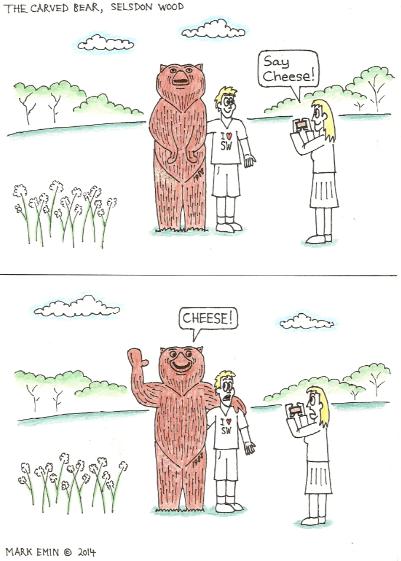
Selsdon Wood is a Local Nature Reserve (LNR) and is classified as Ancient Semi-Natural Woodland (ASNW). Within in it there are a number of Plantations on Ancient Woodland Sites (PAWS). This page contains further information about the following PAWS:
The Jubilee Plantation
The Centenary Plantation
The Maruje Dale Plantation
Other special areas in the wood include the Gorses, Linden Glade, a stand of Oak by David's Crook and the Addington Border.
Scroll down to find more about these and other features of the wood such as
a couple of Ordnance Survey Trigonometrical (Trig) points
and our much photographed carved bear.
The Jubilee Plantation
In
1977 the Croydon Girl Guide Association sponsored the purchase of 400 oaks and
beeches to be planted in commemoration of the Queen’s Silver Jubilee. The area
was to be called ‘Jubilee Plantation’.
Plans for this were announced in the minutes of the Joint Committee of
Management of the Selsdon Wood Nature Reserve by the Chief Officer of the Parks
Dept in his annual report concerning Selsdon Wood (dated 20 Dec 1977).
The Joint Committee of Management of the Selsdon Wood Nature Reserve then
visited the Wood on 10 May 1978 when they viewed the new plantation. (The
planting was thus carried out sometime in the intervening period but as yet we
have been unable to ascertain any of the details.)
Over the next 35 years this area became rather neglected and so the Friends of Selsdon Wood agreed to work with the Council’s Community Partnership Officer and Forestry Adviser to implement the Management & Action Plan for the plantation.
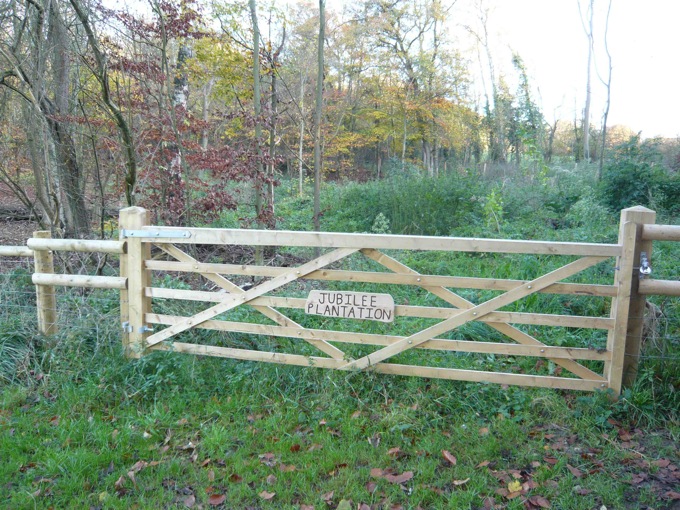 The Friends found that the original planting had been overwhelmed by large
trees like sycamore. The ground was littered with dead trees and branches.
Smaller shrubs like elder and holly could not survive to give cover and food
for birds. This situation was addressed in 2011 A number of the large
trees were removed and the Friends, with Council support, planted 260 trees and
bushes comprising: wild service, field maple, elder, silver birch, hazel, wild
cherry, spindle, guelder rose, blackthorn, and dogwood (see entry for 9th March 2011 on the Workdays page). The Friends are now
trying to keep these free from the potentially overwhelming growth of Old Man's
Beard and other unwanted plants. Sections of the rest of the plot will be
coppiced and pollarded to establish a bird friendly bushy understorey. The
new stock fence, erected by the Council in 2011, is giving some protection to
the new growth - see the photograph taken in 2011.
The Friends found that the original planting had been overwhelmed by large
trees like sycamore. The ground was littered with dead trees and branches.
Smaller shrubs like elder and holly could not survive to give cover and food
for birds. This situation was addressed in 2011 A number of the large
trees were removed and the Friends, with Council support, planted 260 trees and
bushes comprising: wild service, field maple, elder, silver birch, hazel, wild
cherry, spindle, guelder rose, blackthorn, and dogwood (see entry for 9th March 2011 on the Workdays page). The Friends are now
trying to keep these free from the potentially overwhelming growth of Old Man's
Beard and other unwanted plants. Sections of the rest of the plot will be
coppiced and pollarded to establish a bird friendly bushy understorey. The
new stock fence, erected by the Council in 2011, is giving some protection to
the new growth - see the photograph taken in 2011.
Celebrating the Diamond Jubilee
In 2012 the FSW were approached by a representative of the Brownies/Guides, who said that they again had some trees to plant - this time to commemorate the Queen's Diamond Jubilee. Sixty trees were provided by the Woodland Trust, one for each of Her Majesty's 60-year reign and space was found for them in the Jubilee Plantation. The trees comprised 10 Birch; 10 Cherry; 2 Holly; 10 Rose; 10 Rowan; 6 Hazel; 10 Hawthorn; and 2 Dogwood.
The
original date for planting (February 11th 2012) had to be cancelled as the
ground was covered with snow but the event was rearranged for Saturday 3rd
March and the FSW spent a number of days working on the
preparation of the plot - see right. Four sections were mapped out in the southwestern
corner of the plantation and 15 holes were dug in each section, and marked with
a stake labelled with the name of the tree to be planted there.
On
a sunny Saturday afternoon, two dozen Rainbows (aged 5-7), Brownies (aged
7-11) and Guides (aged 10-14) met a number of Friends at 2pm in the car park. The girls came equipped
with their own trowels, spades and gloves and were accompanied by Jo Wheeler,
coordinator for the Brownies and Rainbows, and several supportive parents.
After a group photograph in front of the Selsdon Wood Bear - see below left - David Malins
introduced the project and allocated the young trees (whips), which had been
pre-sorted into four buckets, one for each of the four groups of girls.
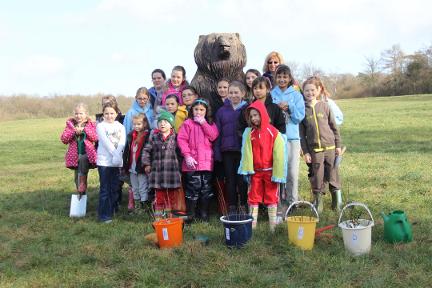
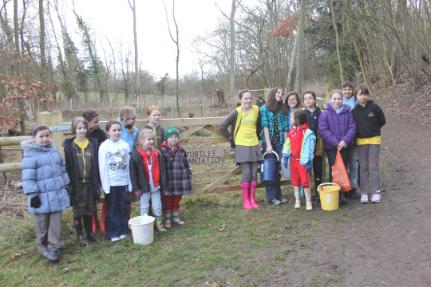
The girls carried their buckets and spades up the hill to the site and after a short instruction (including a warning on staying safe), set to with great enthusiasm to plant the whips in the prepared holes. They watered each planting (the Friends had brought plenty of water) and then stood back to admire their work. The whole task was completed in less than an hour and was rounded off with another photograph - this time in front of the gate with its name board saying ‘Jubilee Plantation’ - above right.
A plaque on the gate commemorates the event - top right.
Each of the girls was given a certificate marking the event the event (bottom right) and all took away a copy of the FSW leaflet and map. Many of the older girls readily spotted the position of the Jubilee Plantation in the map (labelled Jub) and all promised to return in coming years to watch the progress of their saplings.
Quotes from the girls about the event:
Hannah B (Rainbow, aged 5): I liked planting the trees so we can see them grow big and because it's the Queens Jubilee.
Hannah T (Rainbow, aged 5): We planted cherry trees and birch trees for the Queen. I will come back to see how they grow.
Felicity (Brownie, aged 7): The Brownies went to Selsdon Woods. Very nice people work in Selsdon Woods. We planted cherry trees. The wood is important because if we took the trees away, there would just be bare land and the wildlife would go forever! We need to plant trees because people are cutting down trees and trees give us clean air.
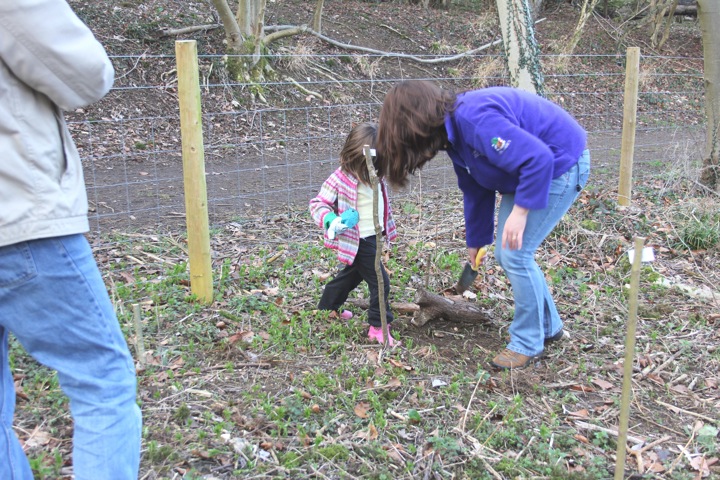 Anna (Brownie, aged 7): When I planted trees I planted a holly tree. I also planted a birch tree.
Anna (Brownie, aged 7): When I planted trees I planted a holly tree. I also planted a birch tree.
Hannah W (Brownie, aged 8): In tree planting I planted 2 spiky hollies, a rowan and finally a wide rose. Together we planted 60 trees in the Jubilee Plantation in Selsdon Woods. It was fun!
Rebecca (Brownie, aged 9): We planted all our birch, hazel and rowan trees in Selsdon Woods. The Jubilee Plantation was divided into 4 sections for us. There were already holes for the baby trees but we had to make sure they were the right size and water the trees when we had planted them.
Lucy (Guide, aged 12): Rainbows, Brownies and Guides went to Selsdon Woods to plant 60 trees between us. It was a very enjoyable experience. Friends of Selsdon Wood were very nice and showed us a secret pond. I'd tell you where it is, but ... it's kind of a ... secret. We can't wait to go back soon to see how our trees are growing. The photograph shows two of the girls planting the last whip.

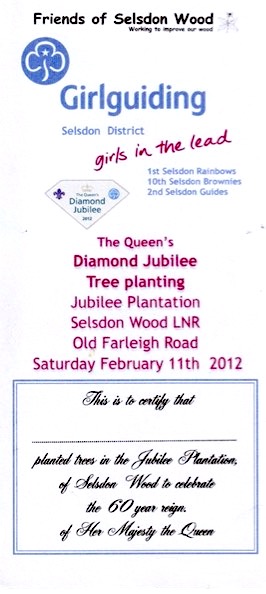

|
Jubilee Plantation trees and shrubs.pdf Size : 412.518 Kb Type : pdf |
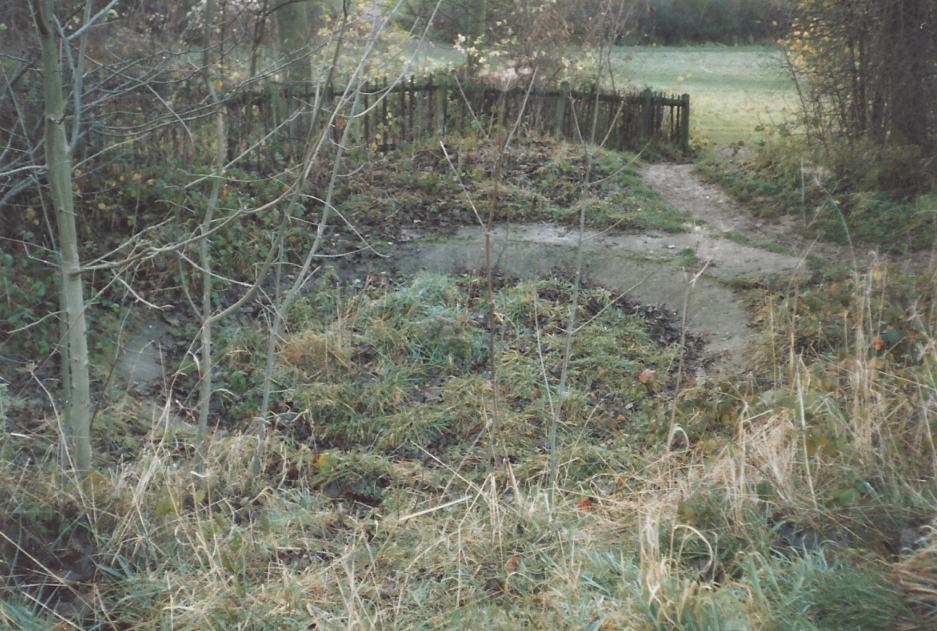 The Jubilee Plantation contains a concrete pond presumably installed when the plantation was created in 1977. This fell into disrepair - see the photograph to the right, taken in 1986 - but at some stage was relined and now does contain water all year round.
The Jubilee Plantation contains a concrete pond presumably installed when the plantation was created in 1977. This fell into disrepair - see the photograph to the right, taken in 1986 - but at some stage was relined and now does contain water all year round.However there is much detritus in the pond which means that the water is poorly oxygenated and cannot support life such as tadpoles or fishes. The cleaner periphery does however provide a drinking (and bathing) place for birds and woodland animals and the rotting vegetation is an ideal breeding place for water lice and many hoverflies and other insects.

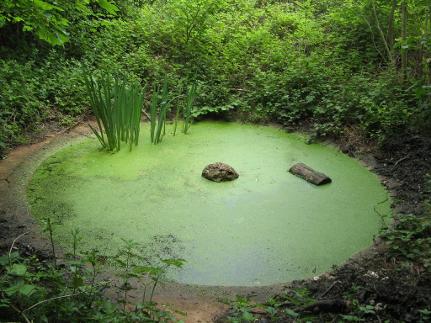
The Centenary Plantation was created in 1983 to commemorate the centenary of Croydon Council. One hundred English Oaks and Birch trees were planted with the intention that the Birch would be felled when the Oak had matured - see photograph below left taken in 1986.
The scheme was originated by Croydon Councillor, Dudley Mead and was paid for by public subscription by Selsdon residents. In Selsdon library there is a book containing the names of all who subscribed (£5 per tree - quite a lot in 1983).
Four of the trees along the edge of the field can be seen to be larger than the others. These were planted as heavy standards and were about 10 years old at the time of planting. The others were much younger whips that took quite some time to become established.
There was a planting ceremony attended by the then Mayor, Councillor Peggy Campbell, and the member of Parliament for Croydon South, the Rt Hon Sir William Clark (both now deceased).2009
This area was subject to a Council Management & Action Plan to be implemented by the Friends of Selsdon Wood in partnership with the Council’s Community Partnership Officer and Forestry Adviser.
Early in 2009 the Friends embarked on a systematic clearance of the seedlings, saplings and plant growth that were overwhelming the original oaks of the Centenary Plantation. They also removed dead and distorted growth from the oaks in an attempt to restore the original stand. It is a pity that squirrels cause so much damage to trees. The cuttings were used to form a dry hedge to give some protection to the plantation. A surprise bonus was the emergence of a large number of white helleborines and a solitary clump of broad-leaved helleborines. These are relatives of the orchid family.
There is more work to be done but we hope you agree that the appearance of the plantation is now more attractive - a big improvement on the uncontrolled thicket it had become - see the photograph below right taken in May 2012.
February 2017
Our thanks to Peter Underwood, Senior Project Officer for The Conservation Volunteers, who, with a colleague, spent a wet miserable day brush cutting the Ash seedlings and bramble in the Centenary Plantation (see photo to the right).
The FSW wish to see this area kept as an Oak plantation as originally designed but we do not have the resources to undertake the removal of the thousands of Ash seedlings which threaten to swamp the Oaks so we are especially grateful to TCV for their help with this.
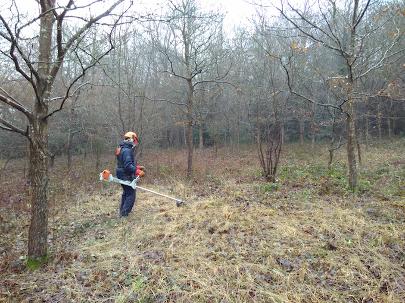
Maruje Dale Plantation
A wooden plaque can be seen on a pine tree buried in a plantation on the left of Greenhill Way, just after entering the wood from Green Hill.
Mrs Chris Alexander, a local resident, informed the Friends that the wooden plaque was linked to her husband, Gordon Alexander. In the late 70s, early 80s he was responsible for running a Youth Opportunities Scheme in Selsdon Wood while employed in the Croydon Council Parks department. He has since retired. The name of the plantation was made up from the names of the young people who took part. During their training they covered coppicing and maintenance work and they were taught how to make benches and bird boxes with the wood. New trees were also planted - mainly beech. Gordon Alexander has provided us with some photographs from the time.
In 2011 many of the benches are still in use but the legs and joints of some show advanced signs of rot. A few have been renovated by the Friends by cutting down old guide posts.
Photographs show work underway in 1970/80 and the Maruje Dale plaque.
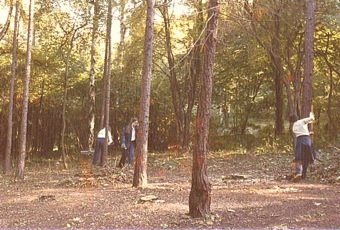
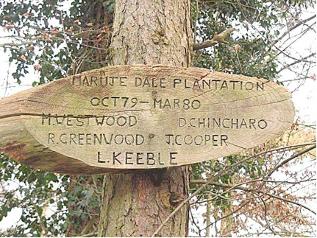
Gorse has acquired many names from different parts of the country - Furze, Gorst, Fuzz, Vuzz and Whin. Also - Fingers and Thumbs, French Fuzz, Furra, Hawth, Hoth, Honey-bottle, Ling, and Pins and Needles.
We have been
puzzling over the reason for the hundreds of Gorse plants that sprang up when
the Larch plantation was felled. We know from an 1800 map that the area bounded
by East Gorse, West Gorse and Farleigh Border used to be called Broad Field and
may have been used for arable crops. Then the 1898 Ordnance Survey shows that
the plot was covered in scrub. The same 1898 map shows chalk pits and Limekiln
Shaw in nearby Farley (Farleigh). Before the coal trade developed, Gorse was of
great value – a fuel for bakers, brickmakers, lime-burners and farmer’s wives.
Many farms had their ‘vuzz’ break. The Vuzz was cut and faggoted and used to fire
bread ovens. In addition, crushing the spines made it suitable for winter feed
for stock. It is possible that the Gorse in Selsdon Wood was grown to fire limekilns.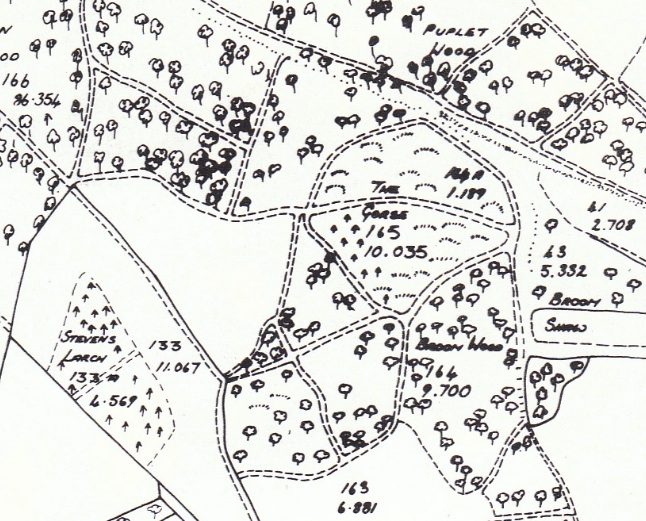
A Friend of Kelsey Park brought much of the above information to our attention from Geoffrey Grigson’s ‘An Englishman’s Flora’.
Gorse is not usually associated with sinister happenings but one should not ignore the grim progress of the soul in the Lyke Wake Dirge which Yorkshire folk sang over their dead:
When thou from hence away art past, Every nighte and alle, To Whinny-muir thou com'st at last; And Christ receive thy saule.
If ever thou gavest hosen and shoon, Every nighte and alle, Sit thee down and put them on; And Christ receive thy saule.
If hosen and shoon thou ne'er gav'st nane, Every nighte and alle, The whinnies shall prick thee to the bare bane; And Christ receive thy saule ...
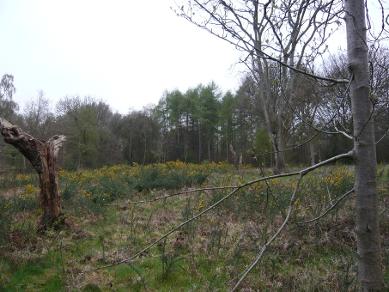
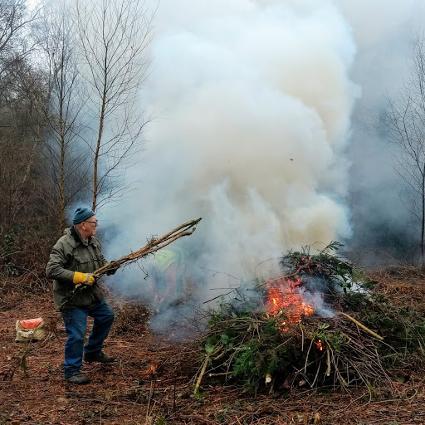
Linden Glade gains its name from the 5 Lime trees planted in a semicircle around the edge of the glade - probably around 1980. The Lime (known in earlier times as Linden) was
part of
the ancient Wild Wood and Limes were coppiced up to the Middle Ages to provide timber
for building, furniture, carving, firewood and rope-making. Monks kept their
hives beneath the trees for the rich pale honey and the flowers were used to
produce herbal medicines and tea. In more modern times the wood has been used
for guitars and wind instruments. When explorers brought back hemp for
ropemaking the tree fell into decline, being replaced by the more productive
hazel which abounds in Selsdon Wood today. One of our Limes has been pollarded
in a gale and the resulting long stems must be typical of what was used for
rope making.
.
Linden Glade houses the Memorial Bird Pool presented by Col. H.S. Wood, I.M.S.and Mrs Wood, of Kensington at the time of the opening of the wood as a public Nature Reserve in 1930. (See the History page for details.) There was a water supply to the bird pool but this was cut off some years ago as it was too expensive to maintain. The pond filled with mud and fell into disrepair but was restored by a project undertaken by FSW in 2016. See the Projects page for details.
A small memorial stone is set there with the following inscription:
These are the things we prize and hold of dearest worth:
The light of the sapphire skies, Peace of the silent hills.
Shelter of the forests, comfort of the grass,
Music of birds, murmur of little rills,
Henry Van Dyke
We dearly loved the birds - Be kind to them
Photographs show Linden Glade in February 2017 and Autumn 2011.
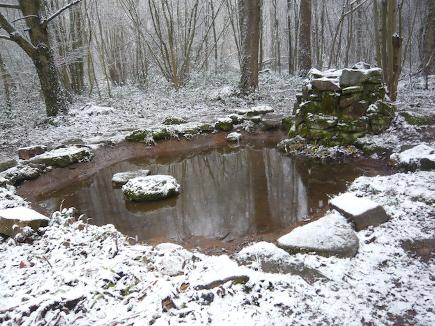
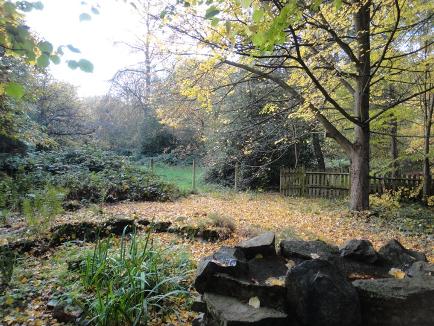
This group of Oaks was planted in 1986 to mark the opening of the National Trust Nature Reserve (see the History page). A plaque was placed to mark these
The Addington Border, which now forms part of the London Loop and Vanguard Way, parallels the old boundary between the Archbishop of Canterbury's Addington Estate and the borough of Croydon. It was originally marked by a line of Yew trees and many of their descendants can still be found along its length. It was also marked by the Addington Border ditch & flint ridge, remnants of which can still be seen crossing Court Wood Grove just NE of the Addington Border path and crossing Avis Grove and Broad Walk. There is an 1928 Boundary marker in the ditch by Court Wood Grove and remains of old field edges are marked by other flint ridges across Court Wood Grove and other paths.
(more photos to come)
These stones are almost certainly an old Ordnance Survey Trigonometry Points (or Triangulation stations).


Do we have any more of these in the wood?
The carved bear that greets visitors beside the car park was carved in the first year of the Croydon Forestry Show (1988) as a spectator event during the show. It was carved by a local tree surgeon, Selwyn Smith who now lives in Wales. (For more about the Forestry Show see the History page of this website.)
The cartoon to the right - showing our famous bear - was produced by Mark Emin and first published in the Selsdon Gazette in 2014. Mark has a BSc in Mathematics and a passion for art including drawing cartoons and landscapes. He also enjoys taking photos of beautiful scenery and wildlife. He has a twitter page with more of his drawings at:
